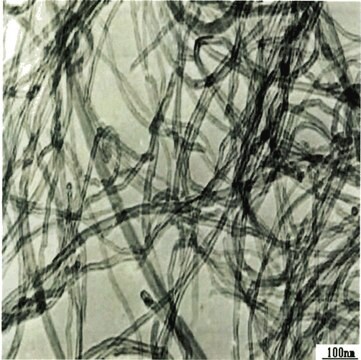901082
Carbon nanotube sheet
aligned, size × thickness 100 mm × 100 mm × 1-5 μm
Synonyme(s) :
MWCNT, MWNT, Multiwall carbon nanotube
About This Item
Produits recommandés
Niveau de qualité
Pureté
>95% (carbon)
Résistivité
10-1000 Ω/sq
Taille × épaisseur
100 mm × 100 mm × 1-5 μm
Diamètre
10-40 nm (carbon nanotubes)
Vous recherchez des produits similaires ? Visite Guide de comparaison des produits
Description générale
CNT has a multi-walled structure. Crystal quality of CNT is examined by Raman scattering measurement. Intensity ratio of G-peak (1580 cm-1) and D-peak (1350 cm-1) represents quality of graphitization of carbon materials. G/D of CNT is ∼3, showing high crystal quality. The high crystallinity is supported by transmission electron microscopy.
Notes préparatoires
Code de la classe de stockage
11 - Combustible Solids
Classe de danger pour l'eau (WGK)
WGK 3
Point d'éclair (°F)
Not applicable
Point d'éclair (°C)
Not applicable
Faites votre choix parmi les versions les plus récentes :
Certificats d'analyse (COA)
Vous ne trouvez pas la bonne version ?
Si vous avez besoin d'une version particulière, vous pouvez rechercher un certificat spécifique par le numéro de lot.
Déjà en possession de ce produit ?
Retrouvez la documentation relative aux produits que vous avez récemment achetés dans la Bibliothèque de documents.
Les clients ont également consulté
Articles
A drawable Carbon Nanotube (CNT) array is a special type of CNT forest, in which individual nanotubes are aligned and grown vertically on a substrate through a chemical vapor deposition (CVD) process. Most strikingly, a macroscopically aligned, pure, and pristine CNT sheet can be continuously drawn out of the array, parallel to the drawing direction, as a result of a delicate interactive force established between neighboring CNTs. Carbon nanotube array has opened the door to practical applications of carbon nanotubes and multifunctional CNT composites, enabling exciting future innovations
Professor Rivnay (Northwestern University, USA) discusses using organic mixed conductors as an alternative to efficiently bridge the ionic world of biology with contemporary microelectronics.
Dr. Tan and researcher introduce recent trends in Self-healing Soft Electronic Materials and Devices. The emergence of smart, functional SHPs will be highly beneficial to the advancement of the next-generation self-healing soft electronic devices. Autonomously self-healing devices could help to minimize the need for repair or replacement of electronics and machines, potentially reducing the cost of materials and reducing electronic waste.
Graphene nanoribbons (GNRs) are quasi-one-dimensional narrow strips of graphene comprised of sp2-hybridized carbon atoms arranged into hexagonal honeycomb lattice configurations.
Notre équipe de scientifiques dispose d'une expérience dans tous les secteurs de la recherche, notamment en sciences de la vie, science des matériaux, synthèse chimique, chromatographie, analyse et dans de nombreux autres domaines..
Contacter notre Service technique





